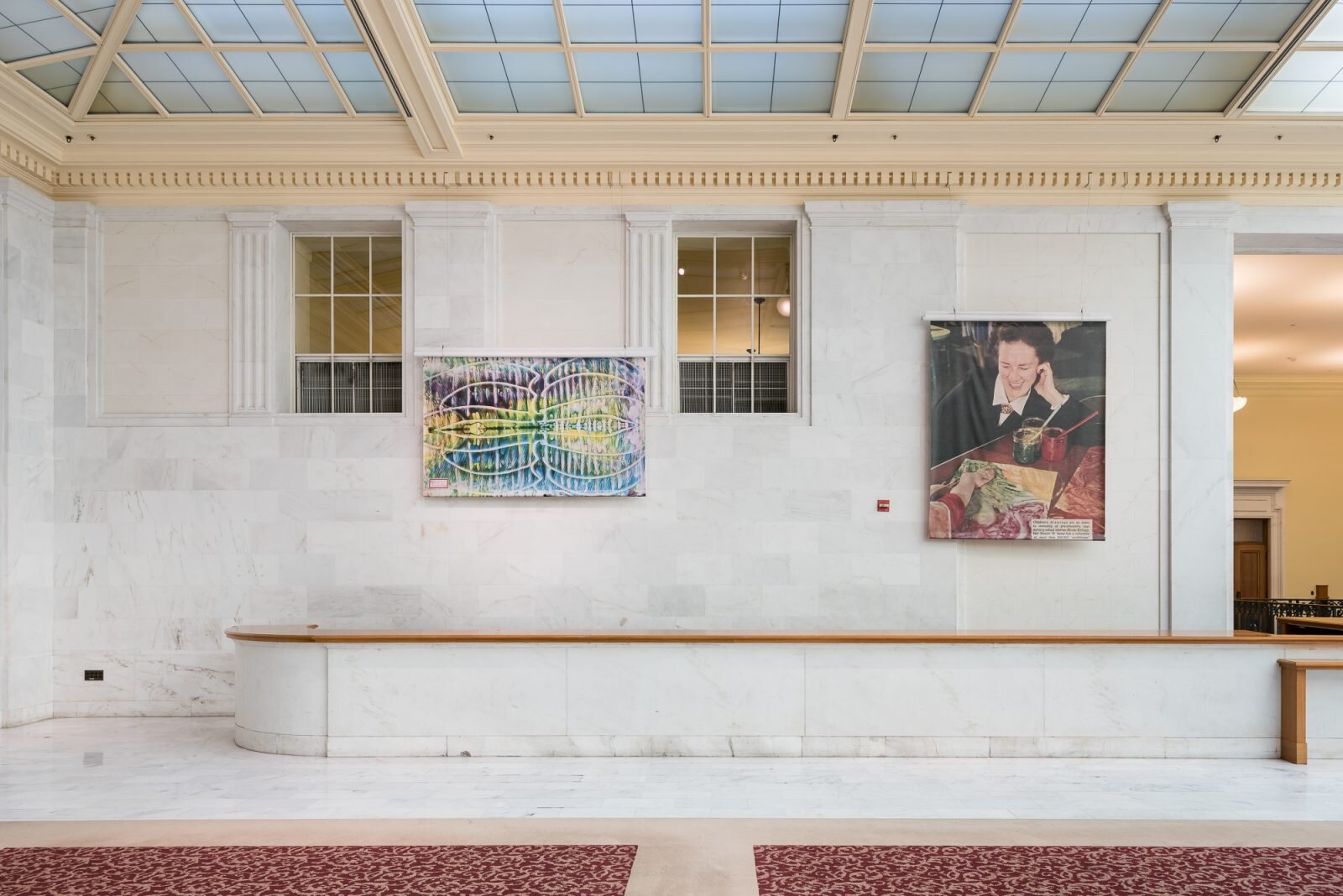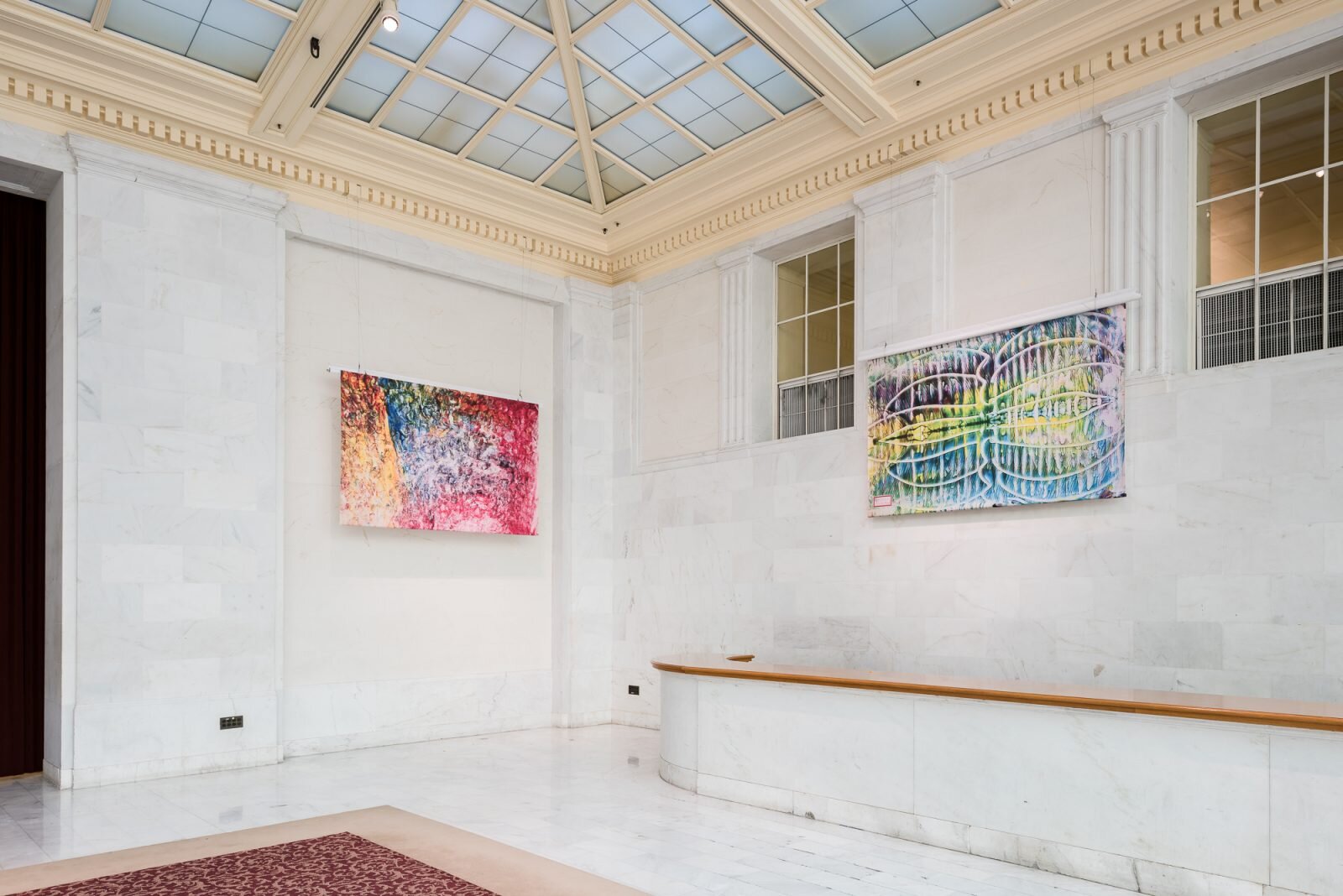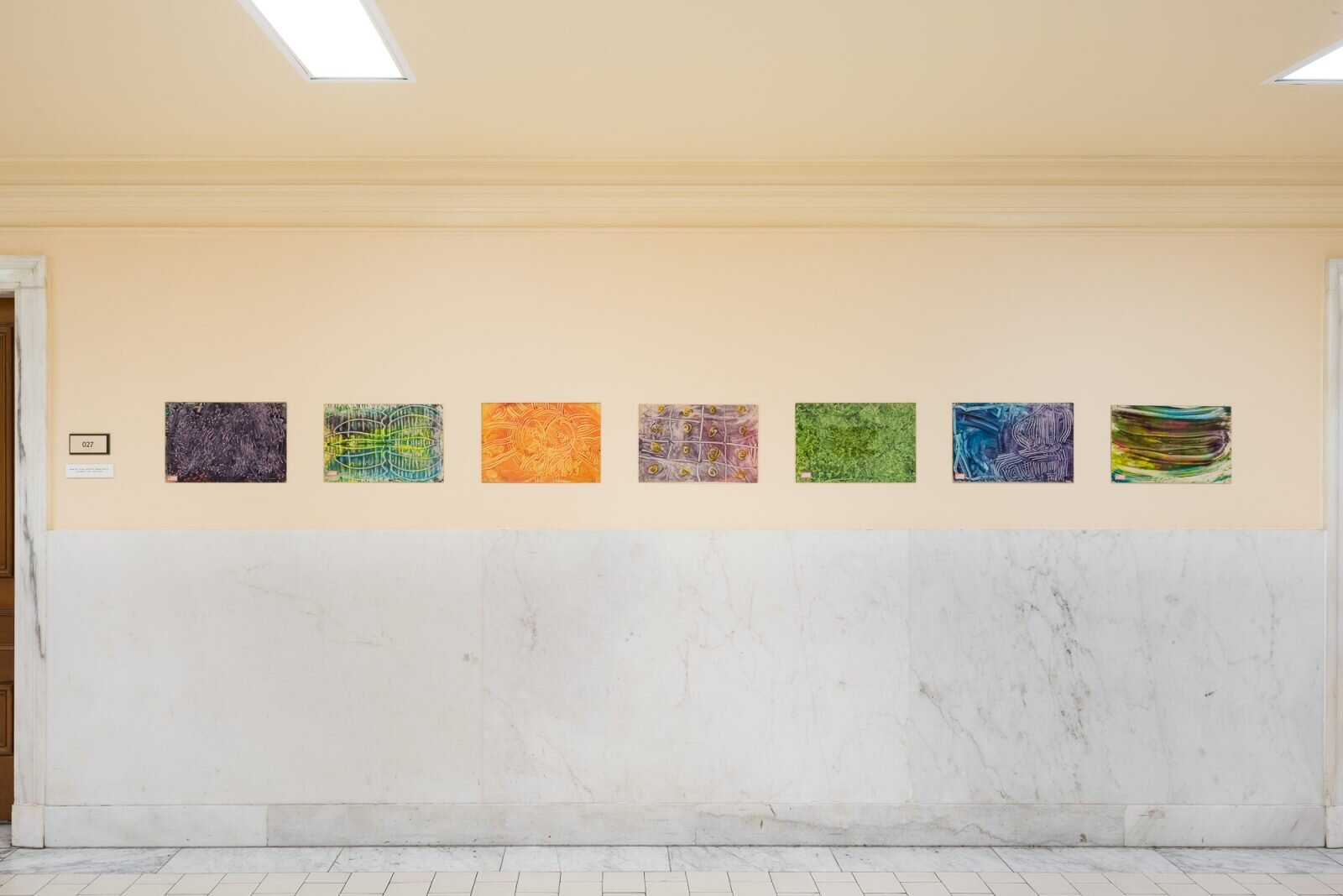
Curated by Lindsey White and Jordan Stein
AT SAN FRANCISCO CITY HALL ON VIEW TILL MARCH 13, 2020
RHODASCOPE brings together approximately 200 artworks from the Rhoda Kellogg International Child Art Collection selected by Belott; Belott’s own child art “forgery” paintings; and several of Kellogg’s original artworks, produced during her final years and never before seen in San Francisco.

Brian Belott, the Brooklyn-based artist and child art enthusiast, came across Rhoda Kellogg’s name again and again in the course of his open-ended research. How could one person, he wondered, be so central to a field of study and yet relatively under-recognized? Kellogg (1898–1987) was an early childhood scholar, educator, author, and activist who was in a near-continual state of processing child art for six decades, most significantly as the designer and director of the Phoebe A. Hearst Preschool, which still operates in San Francisco.

Belott’s curiosity eventually led him to a Connecticut storage facility holding over two million drawings by children–the largest survey of scribbles and finger paintings ever conducted. He was knocked out, and since then has been a champion and steward of the collection, ringing the bell for Kellogg and her inspiring efforts, often alongside his own creations.

A pioneer in the analysis of child art, Kellogg believed in the fundamental role visual language plays in the emergence of consciousness. Her studies yielded numerous books on the subject, elegant classification systems for the early stages of artistic development, and demonstrable evidence that children follow a predictable continuum of graphic development–from scribbles to finger paintings to certain basic forms–universally and across cultures.

“Scribbles are the building blocks of children’s art,” Kellogg noted. “From the moment the child discovers what it looks like and feels like to put these lines down on paper, they have found something they will never lose, they have found art.”

RHODASCOPE brings together approximately 200 artworks from the Rhoda Kellogg International Child Art Collection selected by Belott; Belott’s own child art “forgery” paintings; and several of Kellogg’s original artworks, produced during her final years and never before seen in San Francisco. The exhibition marks a homecoming for the visionary Bay Area figure and her extraordinarily vast, yet profoundly singular collection.

Like Kellogg, Belott processes overwhelming amounts of information through handling, copying, and organizing, simultaneously documenting and reappraising source material most often destined for the trash heap. His works on canvas are handmade copies of drawings and paintings originally made by children. Eccentric and uncanny, the series finds an adult artist striving for the impossibility of total freedom from self-consciousness. They are, in effect, his tribute to childhood.

Kellogg’s cut-paper collages and mixed-media drawings were produced in her 70s and 80s and only recently shown for the first time in New York. Evocative of mandalas, cellular diagrams, and experiments in minimalism, they embody coherence without pretension, questions without answers, and a mind in constant motion.

RHODASCOPE is a play on words that conjures the rotoscope, a device from the early days of cinema used by animators to trace live action footage projected frame-by-frame onto paper. Belott was thrilled to discover that Kellogg copied children’s drawings herself, just as he’d done. We invite you to imagine the artworks in this unique installation as individual frames from a great and impossible film about creativity, perception, value, and collaboration.

Brian Belott (b.1973, East Orange, NJ) is an artist, curator, performer, and publisher based in Brooklyn, NY. He is the lead archivist of the Rhoda Kellogg International Child Art Collection. A lifelong collector of child art, he has studied the work of Rhoda Kellogg for over ten years. He sees the early developmental stages as the most unique aspect of the collection, as they are the richest in scribbling and finger painting.

Rhoda Kellogg (b. 1898, Bruce, WI, d. 1987, San Francisco, CA) was an early childhood scholar, theorist, educator, author and activist. She amassed an extensive and wide-ranging collection of child art—numbering over a million pieces—through her travels in 30 countries around the world and through her work with children at various preschools including the Phoebe A. Hearst Preschool (part of the Golden Gate Kindergarten Association) from 1966-1986.

Kellogg bio continued:
Kellogg earned an international reputation for her pioneering research in children’s art through lecturing, teaching, and publications, notably in her books What Children Scribble and Why (1955), The Psychology of Children’s Art (1967), Analyzing Children’s Art (1969) and Children’s Drawings, Children’s Minds (1979).

Kellogg bio continued: Over the course of her career, she developed a classification system that describes the development of graphic expression in young children. Her research demonstrated that children follow a predictable continuum of graphic development, from scribbles through certain basic forms, and that this development is universal, across cultures. She created new metrics by which to view and interpret child art and advocated for a “whole child” approach to learning long before that was the widely held practice it is today.

All archival child art works and works by Rhoda Kellogg are courtesy of the Rhoda Kellogg International Child Art Collection of the Golden Gate Kindergarten Association / Phoebe Hearst Preschool.

Special Thanks to San Francisco Art Commission, Brian Belott, Jack Lawler, Jenn Digioia, and Phoebe Hearst Preschool























Curated by Lindsey White and Jordan Stein
AT SAN FRANCISCO CITY HALL ON VIEW TILL MARCH 13, 2020
RHODASCOPE brings together approximately 200 artworks from the Rhoda Kellogg International Child Art Collection selected by Belott; Belott’s own child art “forgery” paintings; and several of Kellogg’s original artworks, produced during her final years and never before seen in San Francisco.
Brian Belott, the Brooklyn-based artist and child art enthusiast, came across Rhoda Kellogg’s name again and again in the course of his open-ended research. How could one person, he wondered, be so central to a field of study and yet relatively under-recognized? Kellogg (1898–1987) was an early childhood scholar, educator, author, and activist who was in a near-continual state of processing child art for six decades, most significantly as the designer and director of the Phoebe A. Hearst Preschool, which still operates in San Francisco.
Belott’s curiosity eventually led him to a Connecticut storage facility holding over two million drawings by children–the largest survey of scribbles and finger paintings ever conducted. He was knocked out, and since then has been a champion and steward of the collection, ringing the bell for Kellogg and her inspiring efforts, often alongside his own creations.
A pioneer in the analysis of child art, Kellogg believed in the fundamental role visual language plays in the emergence of consciousness. Her studies yielded numerous books on the subject, elegant classification systems for the early stages of artistic development, and demonstrable evidence that children follow a predictable continuum of graphic development–from scribbles to finger paintings to certain basic forms–universally and across cultures.
“Scribbles are the building blocks of children’s art,” Kellogg noted. “From the moment the child discovers what it looks like and feels like to put these lines down on paper, they have found something they will never lose, they have found art.”
RHODASCOPE brings together approximately 200 artworks from the Rhoda Kellogg International Child Art Collection selected by Belott; Belott’s own child art “forgery” paintings; and several of Kellogg’s original artworks, produced during her final years and never before seen in San Francisco. The exhibition marks a homecoming for the visionary Bay Area figure and her extraordinarily vast, yet profoundly singular collection.
Like Kellogg, Belott processes overwhelming amounts of information through handling, copying, and organizing, simultaneously documenting and reappraising source material most often destined for the trash heap. His works on canvas are handmade copies of drawings and paintings originally made by children. Eccentric and uncanny, the series finds an adult artist striving for the impossibility of total freedom from self-consciousness. They are, in effect, his tribute to childhood.
Kellogg’s cut-paper collages and mixed-media drawings were produced in her 70s and 80s and only recently shown for the first time in New York. Evocative of mandalas, cellular diagrams, and experiments in minimalism, they embody coherence without pretension, questions without answers, and a mind in constant motion.
RHODASCOPE is a play on words that conjures the rotoscope, a device from the early days of cinema used by animators to trace live action footage projected frame-by-frame onto paper. Belott was thrilled to discover that Kellogg copied children’s drawings herself, just as he’d done. We invite you to imagine the artworks in this unique installation as individual frames from a great and impossible film about creativity, perception, value, and collaboration.
Brian Belott (b.1973, East Orange, NJ) is an artist, curator, performer, and publisher based in Brooklyn, NY. He is the lead archivist of the Rhoda Kellogg International Child Art Collection. A lifelong collector of child art, he has studied the work of Rhoda Kellogg for over ten years. He sees the early developmental stages as the most unique aspect of the collection, as they are the richest in scribbling and finger painting.
Rhoda Kellogg (b. 1898, Bruce, WI, d. 1987, San Francisco, CA) was an early childhood scholar, theorist, educator, author and activist. She amassed an extensive and wide-ranging collection of child art—numbering over a million pieces—through her travels in 30 countries around the world and through her work with children at various preschools including the Phoebe A. Hearst Preschool (part of the Golden Gate Kindergarten Association) from 1966-1986.
Kellogg bio continued:
Kellogg earned an international reputation for her pioneering research in children’s art through lecturing, teaching, and publications, notably in her books What Children Scribble and Why (1955), The Psychology of Children’s Art (1967), Analyzing Children’s Art (1969) and Children’s Drawings, Children’s Minds (1979).
Kellogg bio continued: Over the course of her career, she developed a classification system that describes the development of graphic expression in young children. Her research demonstrated that children follow a predictable continuum of graphic development, from scribbles through certain basic forms, and that this development is universal, across cultures. She created new metrics by which to view and interpret child art and advocated for a “whole child” approach to learning long before that was the widely held practice it is today.
All archival child art works and works by Rhoda Kellogg are courtesy of the Rhoda Kellogg International Child Art Collection of the Golden Gate Kindergarten Association / Phoebe Hearst Preschool.
Special Thanks to San Francisco Art Commission, Brian Belott, Jack Lawler, Jenn Digioia, and Phoebe Hearst Preschool